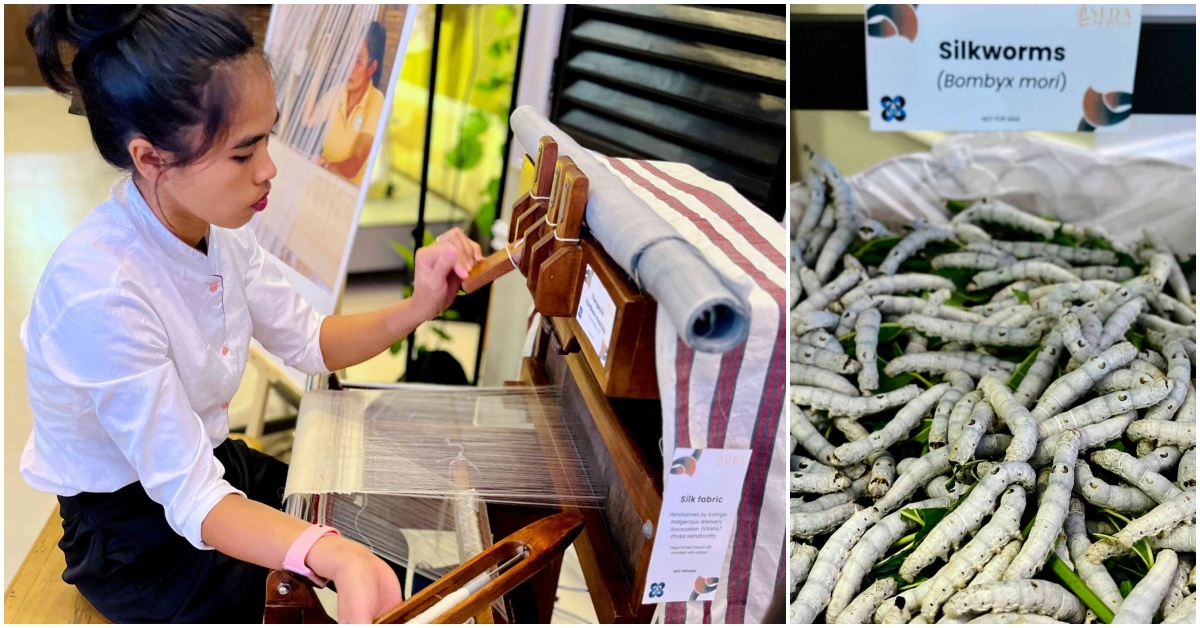
HIGHLY SOUGHT A technician shows the process of producing textiles from silk during an exhibit in Cagayan de Oro City by the Philippine Textile Research Institute on Thursday. At right is a basket of silkworms, the source of the highly sought fabric, displayed during the event. —PHOTOS COURTESY OF DEPARTMENT OF SCIENCE AND TECHNOLOGY-PHILIPPINE TEXTILE RESEARCH INSTITUTE
CAGAYAN DE ORO CITY — The Department of Science and Technology (DOST) is looking at ways to assist mulberry and silkworm farmers amid the rising demand for Philippine silk fabric.
The annual local demand for silk is about 10 tons, but producers can supply only a ton, or just 10 percent, according to Julius Leaño Jr., director of the Philippine Textile Research Institute (PTRI), an agency under the DOST.
“This leads to smuggling of silk into the country to meet current demand,” Leaño noted during the 5th Philippine Silk Industry Summit held here Thursday.
Textile industry players gathered in this Northern Mindanao regional capital for the summit to get updates on the silk fiber industry and discuss its direction in the next six years.
The DOST-PTRI is urging more farmers to get involved in mulberry production to help the industry, Leaño said.
Silkworm feeds on mulberry leaves, and in the country, there are only 162 hectares of land used for propagating, planting, and production of mulberry. Of these, 37.6 ha are in Luzon, 124.6 ha in the Visayas, and only 2 ha in Mindanao.
The limited silk production constrains the industry’s growth.
“For example, in Cagayan de Oro, there are only 3,000 square meters of land used in mulberry growing, hence, silk farmers will also suffer higher production costs to produce silk,” Leaño said.
Skills upgrade
Eugene Galela of the Department of Agriculture’s Philippine Fiber Industry Development Authority stressed the need to upgrade the skills and capabilities of mulberry and silkworm farmers in the face of climate change, and vulnerability to pests and diseases.
He said pests and diseases could impact the health of silkworms and reduce silk production.
Anna Marie Logon, president of Bayo Foundation, which provides production support services, pointed to the need for promotion and support for sericulture, the process of cultivating silkworms and extracting silk from them.
Logon said they were investing in this aspect of the industry, “in the hope that silk production will pick up soon.”
“There is a critical shortage of mulberry, and without a steady supply of it, silk production won’t grow,” she said.
Tech know-how
According to Logon, there is a need for modern techniques in growing mulberry trees and for collaboration between farmers, the government, and the private sector to ensure a steady supply of silk.
Logon stressed that for the industry to grow, there is a need to train farmers, provide financial support, and offer subsidized financing until the silk supply becomes sustainable.
These challenges, Leaño said, are being addressed by the DOST-PTRI as the agency provides eggs and technology support for processing, and later buys silk from farmers.
READ: Spider silk from worms tougher than Kevlar
Nancy Waking, a silkworm farmer from Tuba town in Benguet province, shared that mulberry dies if planted during the dry season, but will have a high survival rate if planted under shades.
“We learn from experience that mulberries can survive and grow on any type of soil. We followed every detail in planting mulberry and in rearing silkworms,” Waking said.
Leaño is hopeful that the exchange of knowledge and experiences during the summit would help spur the mulberry and silkworm industry to grow at an economically viable scale, and bring down the total cost of production.
“The DOST-PTRI aims that by 2030, the country will be self-sufficient for its silk needs and be able to surpass targets as more farmers are enticed to go into mulberry and silk production,” he added. INQ